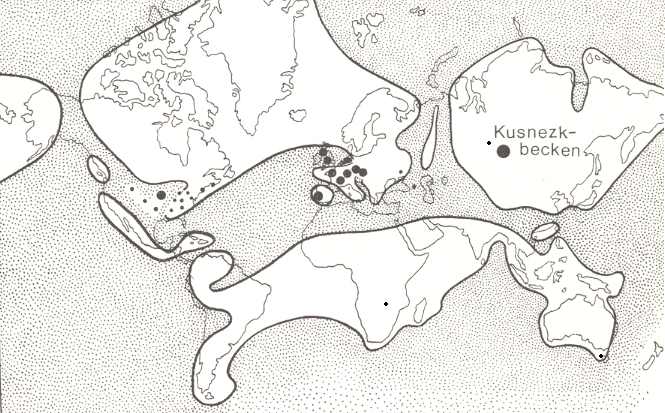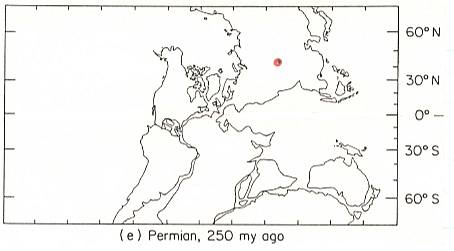

e-mail :  ( Please write in ' Subject ' entry : ' METAPHYSICS ', in order for me to be able to distinguish your mail from spam )
( Please write in ' Subject ' entry : ' METAPHYSICS ', in order for me to be able to distinguish your mail from spam )
Overall geographic and geologic situation of the Kuznets Basin.
The (palaeo-)geographical situation of the Kuznets basin is indicated in the next map :

Figure 1 : Palaeogeography and insect localities in the Upper Carboniferous. From the palaeogeographic maps of TERMIER and TERMIER, SCHUCHERT, and BUBNOFF. The largest of the North American black dots : Mazon Creek (Illinois).
(After HENNIG, 1969. New localities added by PONT and SCHLEE, 1981).
The units, here presented as 'etages' or 'stages' of the Kuzbas (basin of Kuznets), are no strictly chronostratigraphic units such as, for example, the Kazan stage, the Kungur stage, etc. They are so-called 'suites' of which the age is not yet precisely determined.
The basin of Kuznets geographically lies just North of the 'geometric' center of Asia : North of western China / western Mongolia, and just east of the town Novosibirsk, and south-west of the town Krasnojarsk (but closer to Novosibirsk). Politically the Kuzbas lies entirely within the territory of the Sovjet Union (Russia).
In the far north of the basin there is the town Tomsk at the river Tomj. Upstream to the south, also at this river, we have the town Kemerovo, which is the administrative center of the Kuzbas. At about the center of the basin (more or less to the west) there is the town Leninsk-Kuznetsky, and in the southern part of the basin there is, at the river Tomj, the town Novokuznetsk (alias Stalinsk).
The kuzbas is a relatively low-lying region covered with taiga, through which the river Tomj runs, bordered in the west by the Salair-heights, in the east by the Kuznetsk Alataus, and far to the south lies the Altai.
The region is at least 300 km long and about 100 km wide, making it, as to its extent, comparable with that of Holland.
North of the Kuzbas there is the low-land river-basin of the river Obj, of which the Tomj is a tributary discharging itself into the Obj just a little north of Tomsk.
The heights around the Kuzbas consist of Praecambrian and lower and middle Palaeozoic strata.
The basin itself consists of a thick (8-10 km) coal-bearing formation, ranging from the Carboniferous until, and including, the lower Jurassic.
Quaternary ('anthropogenous') deposits normally lie on these strata, while Neogenous, Palaeogenous, and Cretacean continental deposits are only present along the outer edge of the mountains surrounding the coal-bearing strata.
The coal-measures beginning with the Ostrogsk-stage, lie on lime-stone and shales with marine Tournaisian and Visean fossils.
The Kuzbas coal-measures consist of clastic sediments, up to 10 km thick as has been said, and take up the central lower part of the basin.
The estimated ages of the respective stages (suites) are given in the Table below. Meanwhile it is found that the Kuznets-stage has upper Permian (Ufimian) age instead of lower Permian.
| Geologic Age | Suite | Sub-suite | Formation | Thickness in meters |
| Jurassic | Conglomeratic | -- | -- | 700-900 |
| Lower Trias | Mal'tsevian | -- |
Upper Mal'tsevian (variegated) Lower Mal'tsevian (tuffogenous) |
300-400 280-300 |
| Upper Permian | Kol'chuginian |
Upper Kol'chuginian (Yerunakovian) Lower Kol'chuginian |
Gramoteinian Leninskian
Uskatian |
1200-1400 500-700 400-500 600-900 |
| Upper Lower Permian | Kuznyetskian | -- | -- | 700-800 |
|
Lower Permian and Upper and Middle Carboniferous |
Balakhonkian |
Upper Balakhonkian (Lower Permian) Lower Balakhonkian Middle and Upper Carboniferous |
Usyatskian Kemerovian Ishanovo-Intermediate
Alykayevian |
100-170 160-1200
200-600 |
| Namurian | Ostrogian | -- | -- | 200-600 |
| Visean | -- | -- | -- | -- |
| Tournaisian | -- | -- | -- | -- |
Correlation with European strata is not yet (around 1973) definitively determined. Differences in fauna and flora are in this case for an important part accounted for by biogeographic and climatic differences instead of by differences of age.
The conditions under which the coal-bearing strata were formed were changing as time progressed (NALIVKIN, 1962 (1973)) (see next Table) :
The Ostrogsk-stage is (as a lithological body) deposited in near-shore conditions, first in a shallow sea, and thereafter on a near-coast swampy plain, resulting in the first coal-seams.
The Balachon-stages have been deposited entirely on land, whereby the sea was retreating several hundreds of kilometers from the Kuzbas.
The Koljtsjuginsk Series (= Kuznets-stage + Iljinsk-stage + Jerunakowsk-stage) was deposited on the vast river-plains of a large enclosed region separated from the sea by thousands of kilometers.
The Ostrogsk-stage has (here always : within the Kuzbas) only a small number of thin coal-seams.
The Balachon-stages have 30-40 coal-seams of 'economic thickness' of which many are up to 10 meter thick. Some of them reach a thickness of 13-18 meter.
After this a (virtually) coal-free sequens follows, which corresponds with the Kuznets-stage and the Iljinsk stage (together 2200 m thick).
The Jerunakowsk-stage again has a large number of coal-seams of 'economic thickness', 0.5-7.25 m.
The Maljtsewsk-stage (Trias), following upon it, has no coal, but the Jurassic strata, lying on top of it, do have coal again.
The approximate palaeogeographic position of the Kuzbas we here indicate on a palaeogeographic small map taken from WINDLEY, 1986 (see also Figure 1, above) :

The basin of Kuznets is part of the Angara-geosyncline. The latter constituted the southern (at the time perhaps eastern) mobile belt of the Siberian Kraton (Platform). [Far] to the west of this Kraton there was the Ural-geosyncline, and west of the latter there was the European Kraton (= Russian Platform).
The next Table gives the same (sub)stages of the Kuzbas with a change in ranking order and some adjustments of their age based on the entomofauna, according to ROHDENDORF, et al., 1961. The Jerunakowsk, the Iljinsk, and the Kuznetsk suites (stages) together form the Koljtsjuginsk Series.
|
Subdivision of deposits (accepted by the stratigraphic conference in 1956) |
Geologic Age (according to ROHDENDORF, et al., 1961) |
| Suites (stages) | Sub-suites (sub-stages) | |
| Maljtsewsk | -- | T1 ( Lower Triassic) |
| Jerunakowsk |
Tailugansk Gramotjeinsk Leninsk |
P2 ( Upper Permian) |
| Iljinsk |
Uskatsk Kazankowo-markinsk |
P2 ( Upper Permian) |
| Kuznetsk | -- | P1 ( Lower Permian) |
| Upper Balachon |
Usjatsk Kemerowsk Isjanowsk Promjezjutotsjnaja |
C3 ( Upper Carboniferous) |
| Lower Balachon |
Alikajewsk Mazurowsk |
C2 ( Middle Carboniferous) |
| Ostrogsk | -- | C1 ( Lower Carboniferous) |
The Kuznets-stage nowadays (ROHDENDORF et RASNITSIN, 1980 assessed to be of upper Permian age (P2) (ufimian)) is not subdivided into sub-stages. Biostratigraphically it is, according to MARTYNOVA in ROHDENDORF, et al., 1961, clearly divisible into three horizonts.
As to this "based on the fossil insects" we must note the following :
As a consequence of our noëtic theory of evolution, the determination of the age of a given geological formation or deposit (stratum), and its correlation with other geological formations or deposits elsewhere, is not possible on the basis of biostratigraphy because in the latter it is assumed that organismic species evolve in time into other species resulting in a genealogic tree of them ascending through time from early to later epochs. In our theory it is, however, assumed that succession of different organismic species is not the result of material descent from each other. We hold that such a succession of species, as they appear one after the other in the Explicate Order (and evident by the fossil record) is wholly dictated by prevailing ecological conditions. The latter are existential conditions of strategy-contents immaterially produced in the Implicate Order. These strategy-contents are not produced from one another but each one is independently constructed in that Order. If species are produced from one another at all, this always is a production via the Implicate Order, and the point in time, as seen from the Explicate Order, of their appearance in that Order, totally depends on the presence at that time of the proper existental conditions in the Explicate Order. And so it may happen that a 'primitive' species appears in the latter Order much later in time than its more 'derived' cousin, because only at that (later) time the existential conditions for it came into being. See for all this the Theoretic Intermezzo following upon Part VII. This Intermezzo (and its sequel) extensively deals with our noëtic theory of evolution (so far developed). For the leading role of ecological conditions, see (apart from what we already wrote about it in earler documents) in organic evolution (the successive apearance, in the Explicate Order, of different organismic species), especially about halfway in the (first document on the mentioned) Theororetic intermezzo from the Section dealing with Organic strategy-contents and their existential conditions in the Explicate Order, onwards (including the Sequel of the Intermezzo).
So the only way to determine the relative age of a geologic formation or deposit is its position within the overall series of formations or deposits of which it is a part. If, and only if, such a series has not been too much deformed by tectonics (i.e. intensively folded, contorted, or having been warped upside down), a given layer or deposit is older than the one on top of it. And the lithological structure of a pack of layers may, in cases, indicate a gap in time between two such layers.
And of course all this holds for sedimentary rocks only.
We shall now present the fossil Blattida (cockroaches) found (in the form of impressions of tegmina only) in the Palaeozoic of the basin of Kuznets. ["middle Carboniferous" and "upper Carboniferous" in the Table below, may, perhaps, respectively be "middle Upper-Carboniferous" and "upper Upper-Carboniferous"]
These, then, were the fossil Blattida found (up until 1961) in the palaeozoic strata of the basin of Kuznets.
Four families have been identified, viz., Archimylacridae, Spiloblattinidae, Mylacridae, and Poroblattinidae. The majority of them is formed by the Archimylacridae.
(Will be continued . . . )
With this we conclude the exposition of blattarian fauna of the Kuznetz Basin. In the next document we will describe a new wing-type, elytropterygia (shield-wingedness).
e-mail :
 ( Please write in ' Subject ' entry : ' METAPHYSICS ', in order for me to be able to distinguish your mail from spam )
( Please write in ' Subject ' entry : ' METAPHYSICS ', in order for me to be able to distinguish your mail from spam )
To continue click HERE for further study of the types of flight-devices in insects, Part IV, Elytropterygia.
Back to Part IIIbb (noëtic construction of palaeozoic blattida tegmina)